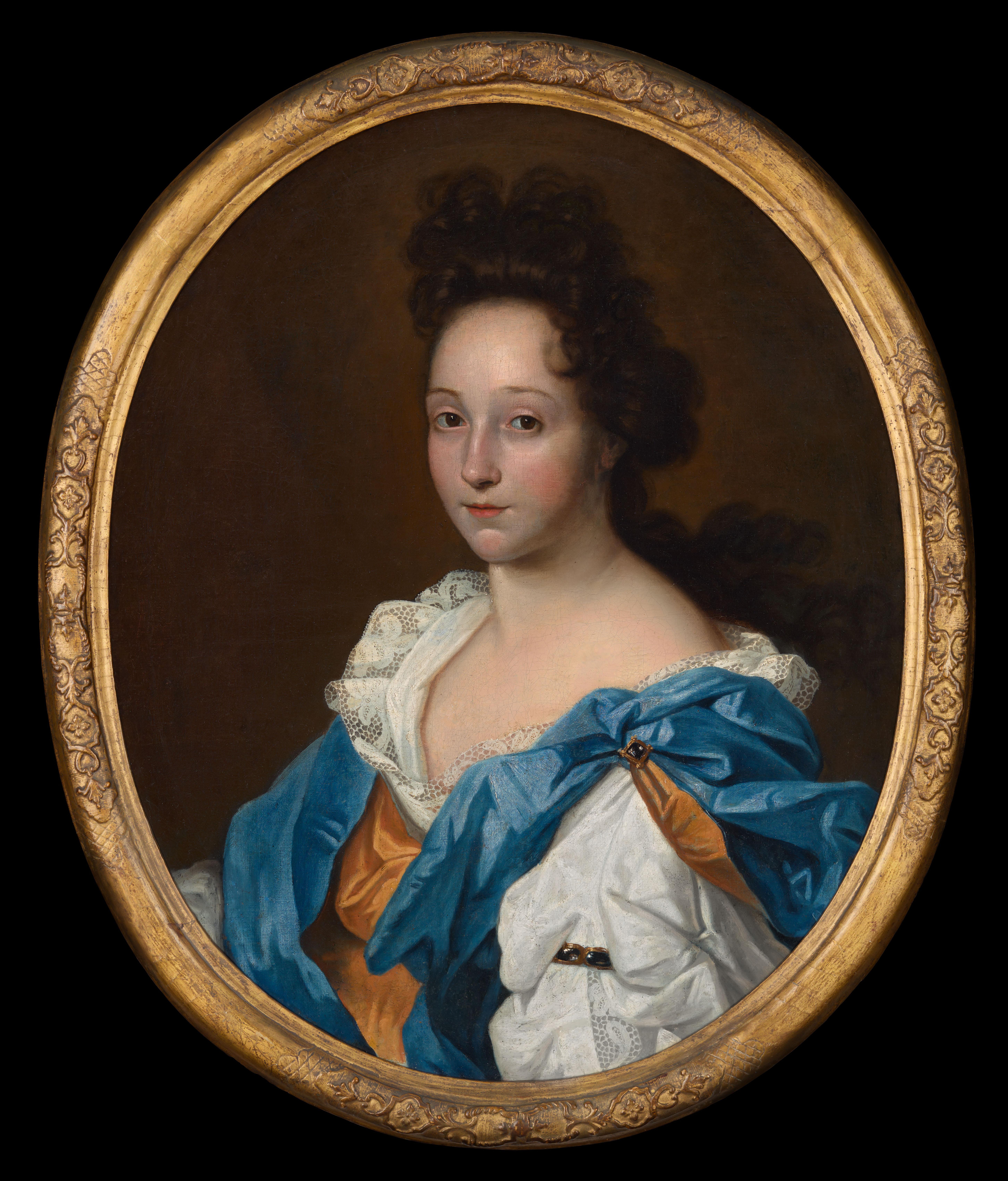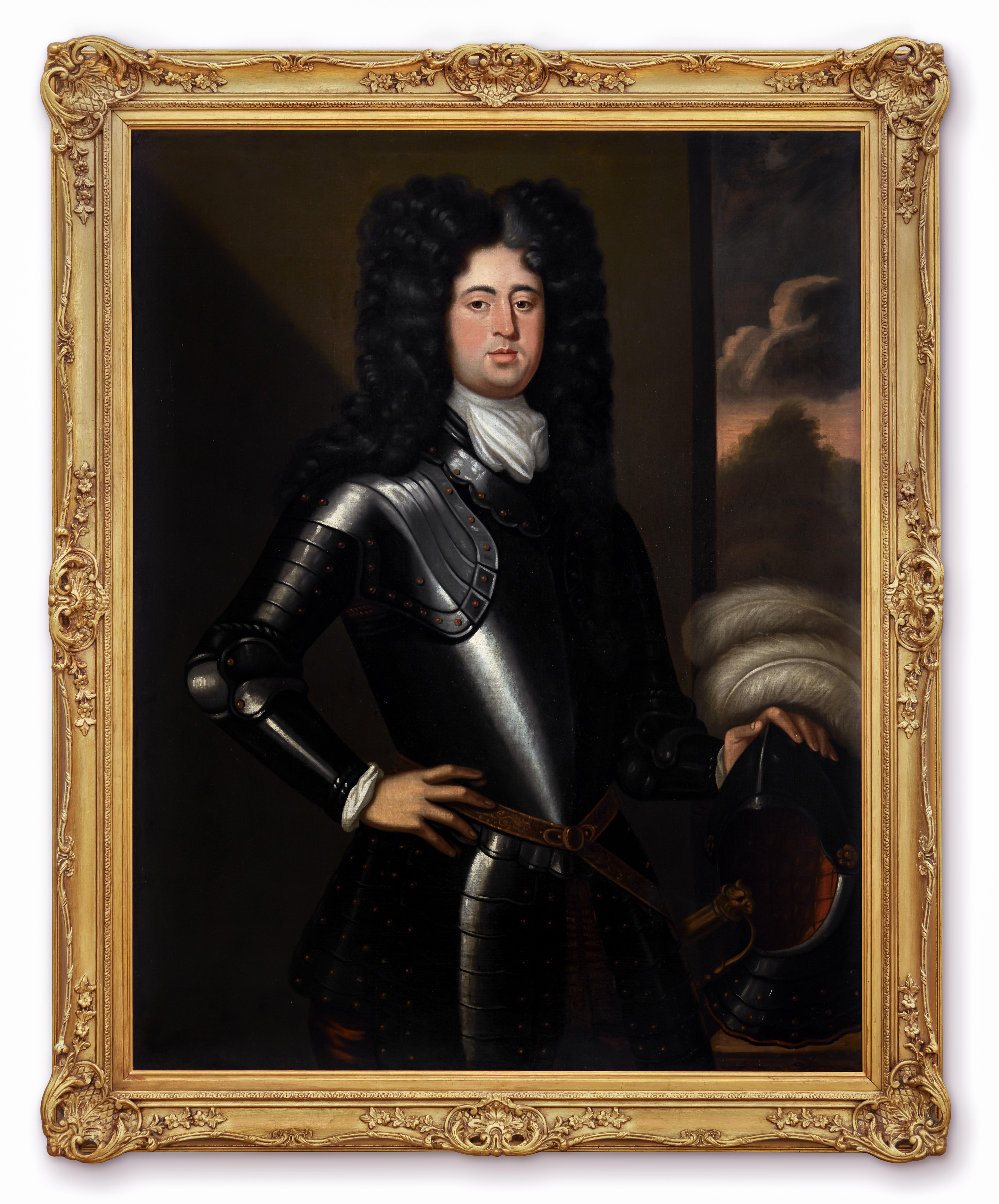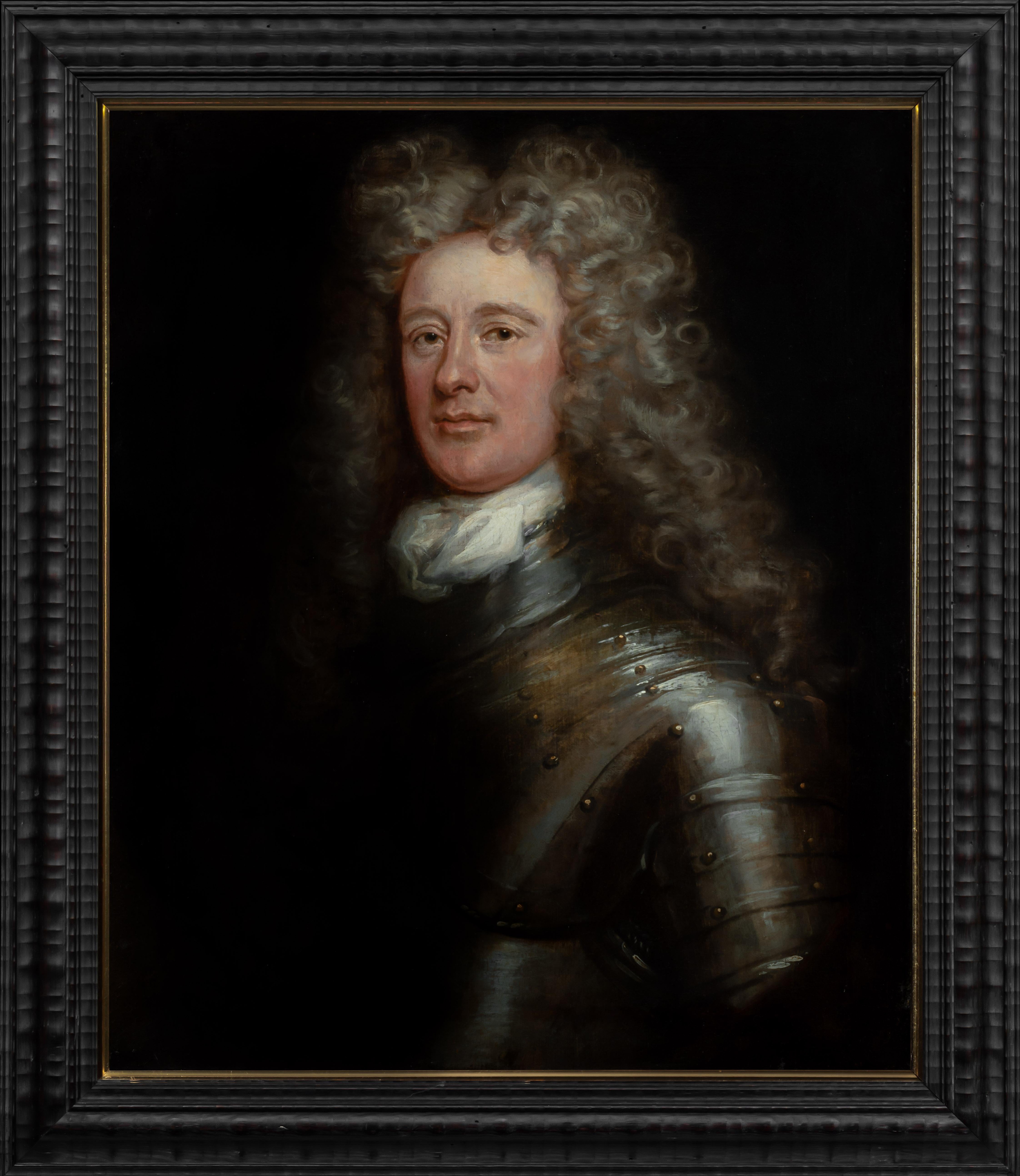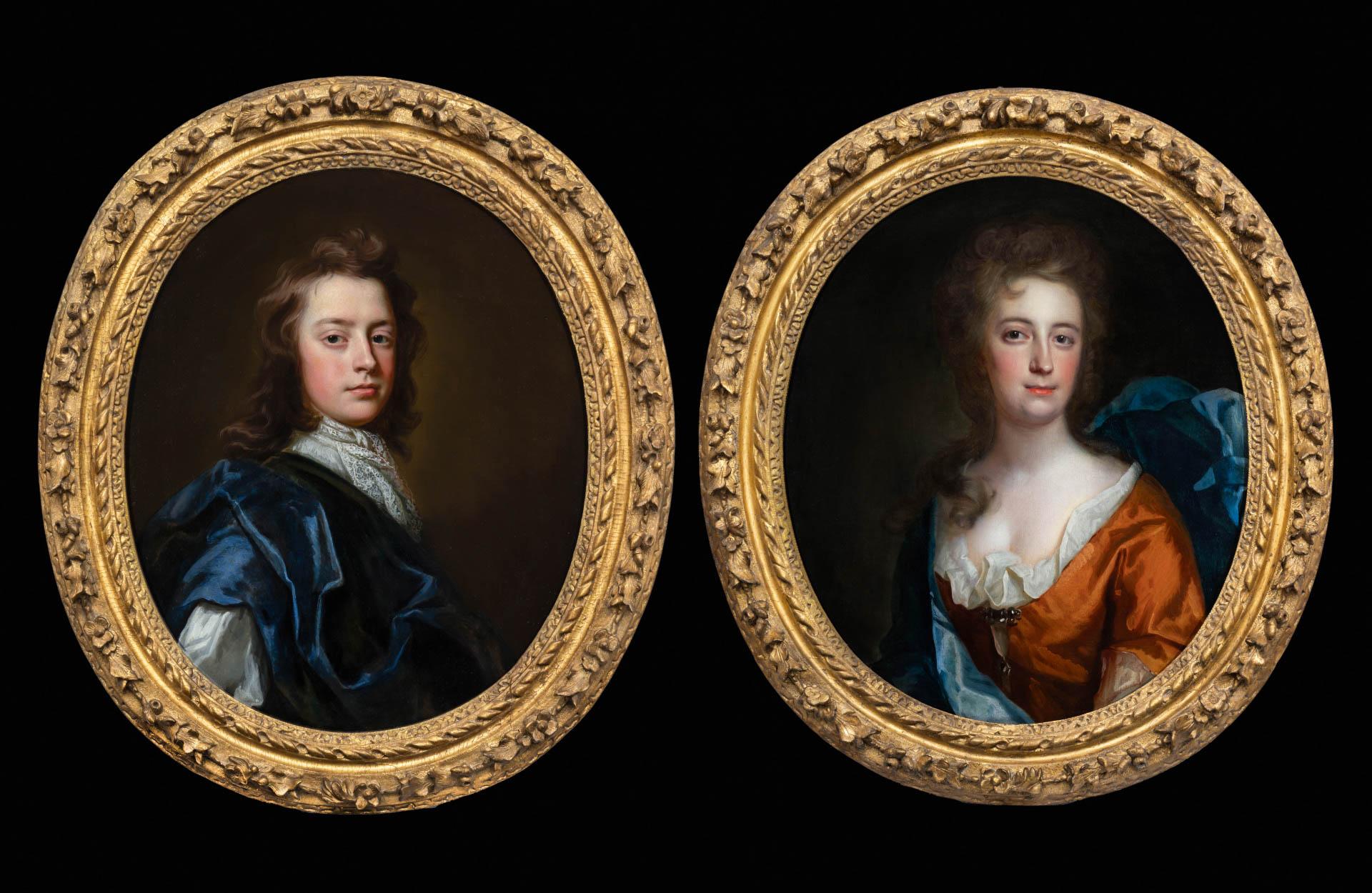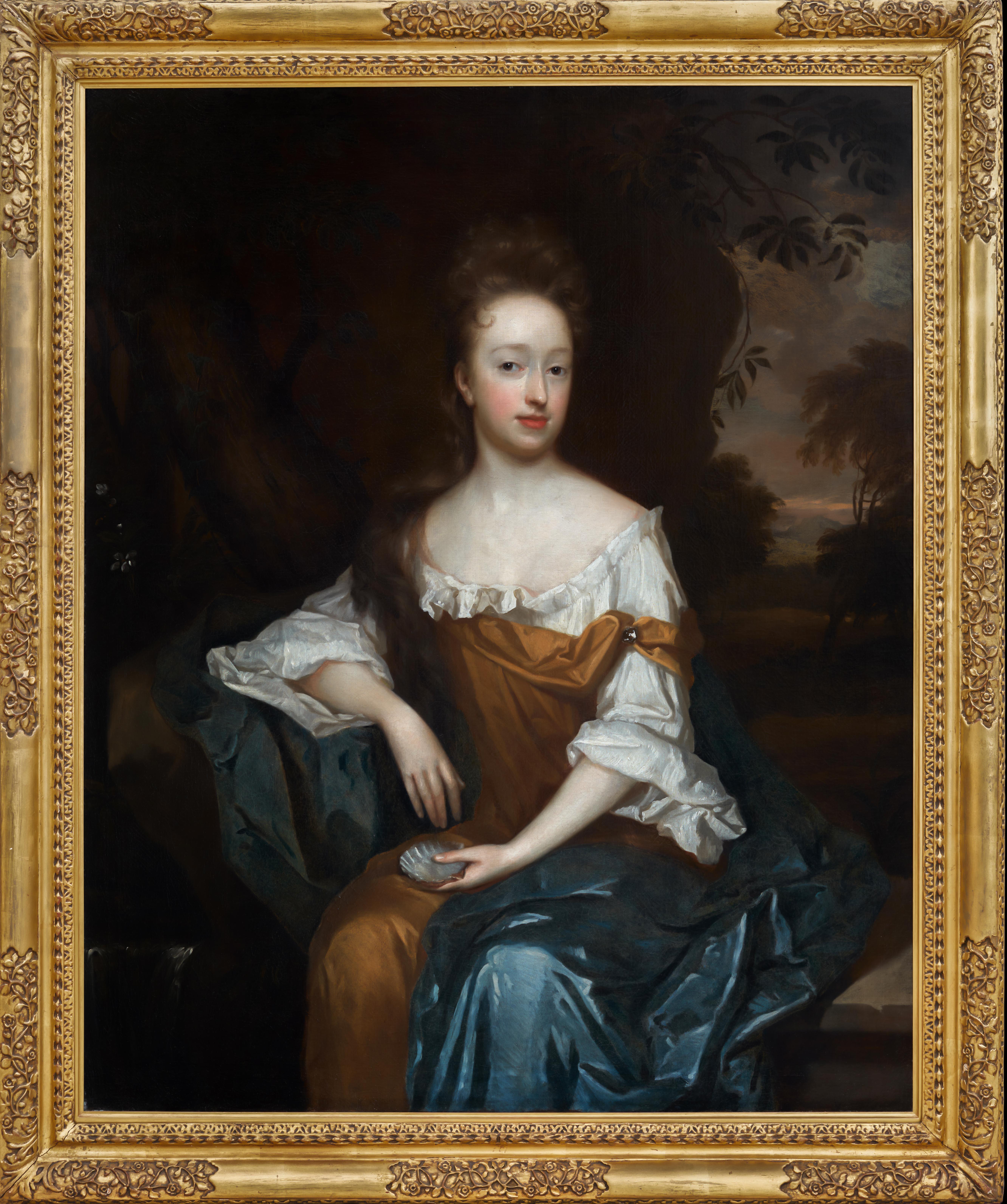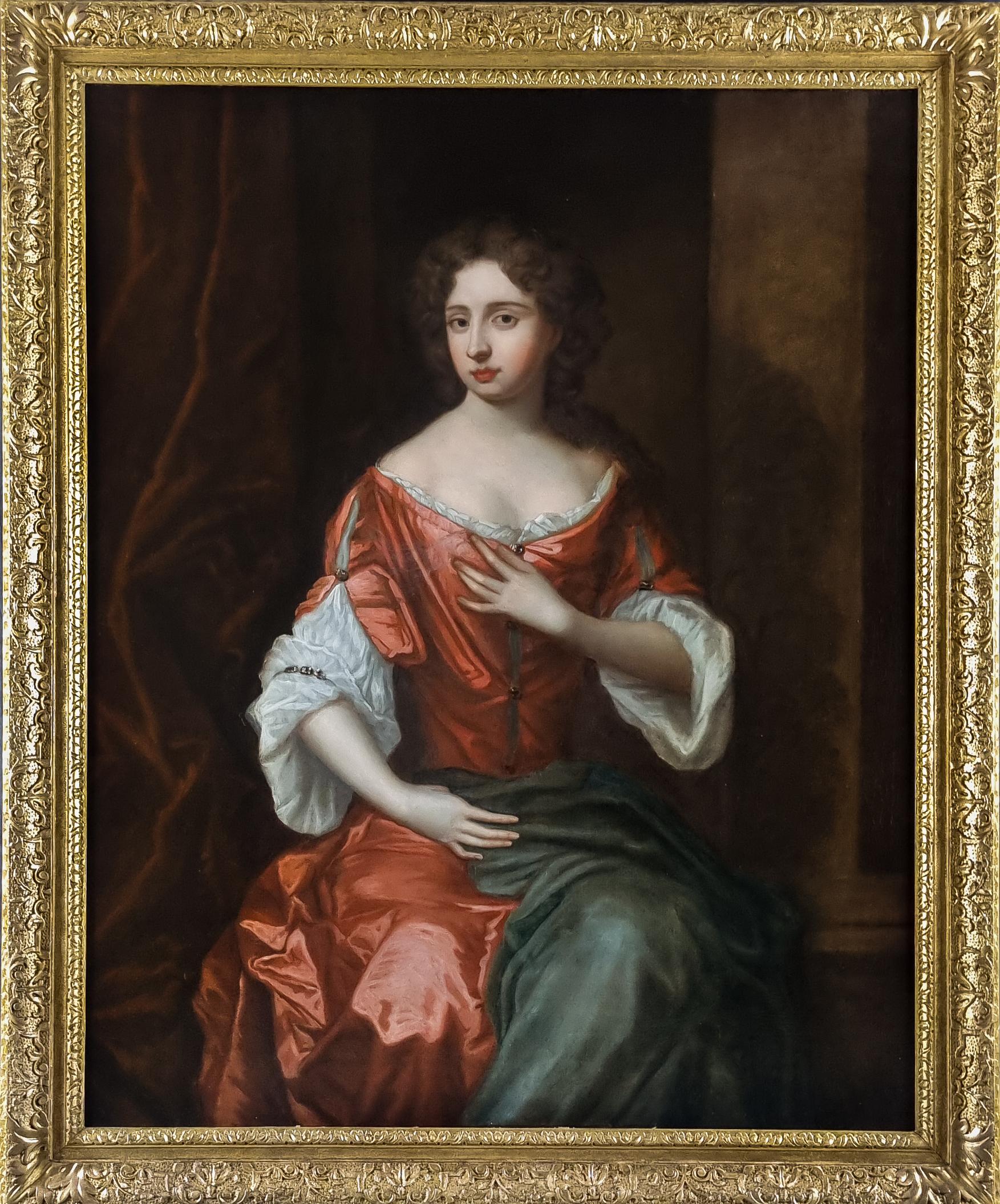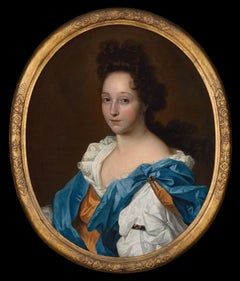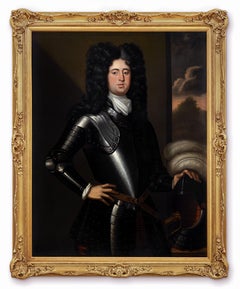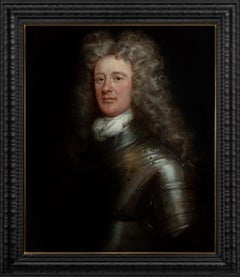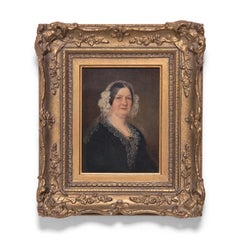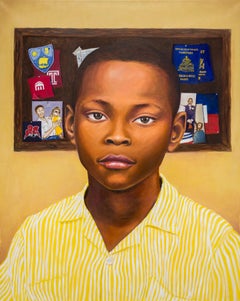Items Similar to Portrait of a Lady, Marie-Madeleine de Chamillart in Landscape Fine oil painting
Want more images or videos?
Request additional images or videos from the seller
1 of 12
Studio of Robert Levrac-TournièresPortrait of a Lady, Marie-Madeleine de Chamillart in Landscape Fine oil paintingcirca 1720
circa 1720
About the Item
This work, offered by Titan Fine Art, formed part of the collection of paintings and family heirlooms of Baron Hugues Alfred Frèdéric de Cabrol de Moute (1909-1997) and his wife, Baroness Marguerite (née d’Harcourt) de Cabrol de Moute (1915-2011). The couple had unimpeachable and enviable family backgrounds, and were descendants of ancient princelings; together they were one of the most prominent high-society couples of the twentieth century and counted the Duke of Duchess of Windsor amongst their closest friends.
This portrait is that of Marie-Madeleine de Chamillart (died 28 May 1751) nee Nicolas de Lusse. She had a daughter, Anne, in 1692. In 1700 she married Clément Chamillart (1663-1708), President of the Accounts of the King's Chamber. The couple had a daughter, Madeleine (born 1701), who married Louis, the only son of Guillaume de Guitaut and Antoinette de Vertamont in 1719. Guillaume de Guitaut resided at Château d'Époisses in Burgundy France and his descendants still live today. A portrait of our sitter is still held at the Château.
Clément Chamillart died in 1708 and our sitter remarried Jean-Baptiste de Johanne de la Carre (1678-1726), marquis de Saumery, maréchal de camp, in 1713. This marriage produced two daughters, Marguerite (died 1729) and Marie Madeleine (born 1720).
Much of the beauty of this elegant portrait resides in its graceful composition – it is a fine example of French portraiture. Beautifully and meticulously rendered throughout, the sitter has been depicted three quarter length in an outdoor setting beside a potted orange tree. The lady is shown in a blue dress with silver detailed décolletage and large voluminous sleeves turned over to reveal elaborately detailed lining. The sumptuous fabrics convey a sense of wealth and prestige. The portrait is striking in its portrayal of the sumptuous fabrics and their decorative richness.
The prominent sprig of orange blossom that she is holding is a traditional representation of marriage and eternal love in art, but it also alludes to youth and freshness, and by virtue of the great expense and difficulty with which it was often grown, to great wealth.
In accordance with the sitter's age and the style of clothing and hair with the curls on the forehead, this portrait can be dated to the 1720s.
Baron Hugues Alfred Frèdéric de Cabrol de Moute (1909-1997) was the son of Roger de Cabrol de Moute and Helen Mary de Lassence. He was one of the more engaging personages in that delightful social constellation of social figures who animated what has become known as "Cafe Society" which was international but inevitably most at home in Paris from the 1920's until the 1960's. He married Marguerite d'Harcourt (1915-2011), known as Daisy, in Paris in 1937, the only daughter of Étienne, Marquis d'Harcourt, and his wife, Marie de Curel. The Harcourt family belongs to the circle of the oldest families in France; the founder of the family, Bernard le Danois, received the seigniory of Harcourt in the tenth century, following the conquest of Normandy. In the 11th century, his descendants took part in the conquest of England alongside William the Conqueror. Later, the Harcourt family was divided into a French branch and an English branch, which successively received the titles of barons, viscounts, and counts.
Marguerite "Daisy" Marie Brigitte Emmanuelle Ghislaine d'Harcourt, Baronne de Cabrol was one of the last survivors of twentieth century French high society. Through her mother, Daisy was a descendant of the great industrial family of Wendel, with iron and steel enterprises in Lorraine; she also descended from Nicolas Soult, one of Napoleon's Marshals and three times Prime Minister of France.
The couple became friends of the Duke and Duchess of Windsor in 1947, and were invited to the Chateau de la Croë, their rented house on Cap d'Antibes. There they found the exiled Windsors living in unusual post-war luxury, serving delicious food and providing fresh sheets every day. Daisy suspected that the Windsors were bored, but, having nothing else to do, were condemned to an endless round of social engagements. She and Fred were among the few allowed to see the Duchess laid out after her death in 1986.
Daisy was a considerable hostess, giving a ball every year for her charity, L'Essor, to which le tout Paris would come. One of these, in 1954, was at the Palais des Glaces, in Paris (later used in the film Gigi), at which she entertained Charlie Chaplin, the Begum Aga Khan and the Windsors. According to Nancy Mitford, the guests all wore £1,000 dresses and leant forward, "bottoms out, arms wildly waving", as they skated on the ice ring. At the end of the evening the ring was scattered with stray diamonds. Daniele Mitterrand, the wife of the future President Francois Mitterrand, was on the organising committee. The composer Henri Sauguet wrote music especially for the evening.
She moved in the world of Marie-Hélène de Rothschild, wife of Baron Guy de Rothschild, and attended the Surrealist Ball at the Chateau de Ferrières in Normandy in 1972. She also frequented the parties given by Vicomtesse Marie-Laure de Noailles, attending her 1951 ball in the guise of a legless and armless woman. She was variously dressed by Jacques Heim, Lanvin and Elsa Schiaparelli, often at the expense of the couturiers themselves. She enjoyed time with Jean Cocteau and the writer Louise de Vilmorin, but felt trapped when on Niarchos's yacht, alongside Douglas Fairbanks Jr. Niarchos was a tyrannical host, refusing to moor the yacht for bathing, while serving daily rations of caviar. "Nobody can eat caviar for eight days in a row," she said of the voyage. Fred and Daisy are remembered for the extraordinary scrapbooks in which they created of the balls and house parties they gave and attended, one resplendent photo is Fred alongside Elizabeth Taylor.
The couple had two residences, their Paris residence was “one of the most beautiful residences in Paris” at 26 Avénue Foch, which is an avenue of elegant stately mansions, alongside the Rothschilds, the Marquis and Marquise de Boisgelin, and the Baron and Baronne Thierry de Zuylen de Nyevelt de Haar. The Cabrols's scarlet‐and‐blue drawing room is a museum of Louis XIV tapestries from Beauvais, Delft china that matches bowls and jars depicted in one of the tapestries, Chinese porcelains, Roman urns, Louis XVI chairs and bronze doré candelabra. They also lived at Grosrouvre, near Montford L'Amaury, south-west of Paris, in a residence with two flagpoles flying her arms and those of Fred.
“My husband is the head of the Cabrol family, so he does not use his first name,” his wife said. The couple had two sons and one daughter. The death of the couple heralded a way of wife that no longer exists.
Our portrait was consigned to a sale upon the Baronne de Cabrol’s death, and described as “Studio of Robert Levrac-Tournières” by a renowned Parisian art expert/appraiser.
We would like to thank Beatrix de Guitaut, Château d'Époisses, for her assistance with the identification of the sitter and biography.
Measurements: Height 169.5cm, Width 132cm framed (Height 66.75”, Width 52” framed)
- Creator:Studio of Robert Levrac-Tournières (1667 - 1752, French)
- Creation Year:circa 1720
- Dimensions:Height: 66.74 in (169.5 cm)Width: 51.97 in (132 cm)Depth: 3.15 in (8 cm)
- Medium:
- Movement & Style:
- Period:
- Condition:In excellent condition having passed a strict condition assessment by a professional conservator prior to going on sale.
- Gallery Location:London, GB
- Reference Number:1stDibs: LU1199112375392
About the Seller
5.0
Platinum Seller
Premium sellers with a 4.7+ rating and 24-hour response times
Established in 1998
1stDibs seller since 2019
43 sales on 1stDibs
Typical response time: 1 hour
- ShippingRetrieving quote...Shipping from: London, United Kingdom
- Return Policy
Authenticity Guarantee
In the unlikely event there’s an issue with an item’s authenticity, contact us within 1 year for a full refund. DetailsMoney-Back Guarantee
If your item is not as described, is damaged in transit, or does not arrive, contact us within 7 days for a full refund. Details24-Hour Cancellation
You have a 24-hour grace period in which to reconsider your purchase, with no questions asked.Vetted Professional Sellers
Our world-class sellers must adhere to strict standards for service and quality, maintaining the integrity of our listings.Price-Match Guarantee
If you find that a seller listed the same item for a lower price elsewhere, we’ll match it.Trusted Global Delivery
Our best-in-class carrier network provides specialized shipping options worldwide, including custom delivery.More From This Seller
View AllPortrait of a Lady in White Chemise, Russet & Blue Drapery c.1695, Oil Painting
By Harman Verelst
Located in London, GB
This lavish portrait, painted circa 1695, is an exquisite example of the type of portrait in vogue during the last quarter of the seventeenth century. It is evident that the artist ...
Category
17th Century Old Masters Portrait Paintings
Materials
Canvas, Oil
Portrait of Gentleman in Armour by Table & Helmut c.1685 Aristocratic Provenance
By Johann Kerseboom
Located in London, GB
Portrait of a Gentleman in Armour beside a Table with Helmut c.1685
Follower or circle of Johann Kerseboom (d.1708)
This exquisite Grand Manner work, presented by Titan Fine Art, wa...
Category
17th Century Old Masters Portrait Paintings
Materials
Canvas, Oil
Portrait of a Gentleman, David Erskine, 13th Laird of Dun, Wearing Armour c.1700
Located in London, GB
The gentleman in this exquisite oil on canvas portrait, presented by Titan Fine Art, is shown with the grandiloquence characteristic of the English School of painting. He is portray...
Category
17th Century Old Masters Portrait Paintings
Materials
Oil, Canvas
Portrait of Gentleman Blue & Cloak, Portrait of Lady, Fine Carved Gilded frames
Located in London, GB
Portrait of a Gentleman with Blue Cloak and Portrait of a Lady in Russet Dress c.1697
Thomas Murray (1663-1735)
These fascinating portraits are exquisite examples of portraiture in ...
Category
17th Century Old Masters Portrait Paintings
Materials
Oil, Canvas
Portrait of a Lady by a Woodland Stream Holding a Shell c.1690; Oil on canvas
By Harman Verelst
Located in London, GB
This elegant portrait, presented by Titan Fine Art, depicts a beautiful young lady seated in a wooded area, resting one arm on a rock, before a landscape and a warm evening sky. She is wearing a white smock under russet-coloured silks, loosely held in place by an immense black diamond clasp on the sleeve, and her body is enveloped in a voluptuous swag of azure silk; the costly fabrics and jewels reveal that the sitter was a paragon of a wealthy and privileged society that she belonged to.
Much of the attractiveness of this portrait resides in its graceful composition and the beauty of the youthful sitter. The flowing water in the left margin of the picture and the shell that she holds are compositional devises often used at the time to allude to her potential as wife and mother, recalling Proverbs, Chapter 5, Verse 18: “Let thye fountain be blessed, and rejoice in the wife of thye youth”. Symbolism was a key component to many works of this period and contemporary viewers would have deciphered them immediately. Such images exude a sense of status and Augustan decorum, and were highly influential in transmitting these values into the first half of the eighteenth century. Held in a good quality and condition gilded antique frame.
Herman Verelst was from a great dynasty of painters, with many members achieving great success. Specialising in portraits and still life paintings, he was one of the legions of foreign-born artists working in England at the time. Today, many of his pictures are given to other artists or are simply relegated to that term “circle of” which is a great disservice because he had an ability to render faces and drapery on par with some of the best artists at the time. Herman’s work is quite distinctive in the way he rendered faces and this particular pose was a favourite. His faces were portrayed with great skill often using the sfumato technique which gave them a very smooth feel to the skin with no hard lines, and many known works by him show that he could also render drapery with great affect. Our painting was painted in the 1690’s.
His father, Pieter Hermansz Verelst...
Category
17th Century Old Masters Portrait Paintings
Materials
Canvas, Oil
Portrait of a Lady in Red Dress on Porch c.1680, English Aristocratic Provenance
Located in London, GB
Presented by Titan Fine Art, this painting formed part of a historic collection of an English aristocratic family, Lord and Lady Sandys at their magnificent baroque and Regency Grade-I listed family home, Ombersley Court. The house was among the most fascinating survivals of its kind in this country. The atmospheric interiors were distinguished above all for the works of art associated with two key moments in national history. The collection was acquired or commissioned over five centuries and remained at Ombersley Court until its recent sale, the first in 294 years. This portrait hung in the Grand Hall.
This exquisite grand manner work is an evocative example of the type of portrait in vogue during a large part of the seventeenth and eighteenth centuries. The artist has depicted an elegant lady, three quarter length and seated on porch with a luxurious crimson swag curtain by her side. The clothing – known as “undress” at the time, consists of red silk fastened at the front and sleeves by large gold and diamond jewels over a simple white chemise. In her lap she holds a blue wrap and in her other hand, at her chest, she clutches the end of a sheer gauzy scarf that has been draped around her body with the other end a type of headdress – this type of sheer scarf was often employed by Wissing in his portraits. The classical architecture signifies cultivation and sophistication and the luxurious swag curtain is a signifier of wealth. The portrait can be dated to circa 1680 based on the sitter’s attire, the “hurluberlu” hairstyle, and other portraits by Wissing using the same formula.
This oil on canvas portrait has been well cared for over its life, which spans almost 350 years. Having recently been treated to remove an obscuring discoloured varnish, the finer details and proper colour can now be fully appreciated.
Once owned by Evesham Abbey, the manor of Ombersley was acquired by the Sandys family in the early 1600s, when Sir Samuel Sandys, the eldest son of Edwin Sandys, Bishop of Worcester and later Archbishop of York, took a lease on the manor, before receiving an outright grant in 1614. The present house, Ombersley Court, dates from the time of Samuel, 1st Lord Sandys, between 1723 and 1730. The house itself is a fine example of an English Georgian country house set in rolling countryside and surrounded by Wellingtonias, planted to commemorate the Battle of Waterloo by Arthur Hill, 2nd Baron Sandys, who played a distinguished part in the battle and was one of the Duke of Wellington’s aides de camp. The Duke also stayed in the house and in the Great Hall, was the Waterloo banner which was brought to the house by Sir Arthur Hill, aide-de-camp to the Duke of Wellington, who succeeded his mother, the Marchioness of Downshire as 2nd Lord Sandys. Further Waterloo memorabilia are kettle drums from battle. The family had a strong tradition of military and political service, dating back to the 17th century, and this was also reflected in the fine collection of portraits and paintings in the house. In short, Ombersley represented a vital aspect of British history. The house and more especially the collection were of the greatest historical importance. Houses that have remained in the possession of the same family for as many as three centuries have become increasingly rare.
Through this portrait, collectors have a chance to acquire a piece of British history and an evocative vestige of a glittering way of life, which is now gone.
Much of the attractiveness of this portrait resides in its graceful manner and the utter beauty of the youthful sitter. Presented in a beautiful carved and gilded period frame, which is a work of art in itself.
Willem Wissing was a Dutch artist who enjoyed a solid artistic training at The Hague under Arnold van Ravesteyn (c.1650-1690) and Willem Dougijns (1630-1697). He came to London in 1676 and most probably joined the studio or Sir Peter Lely as an assistant that same year. After Lely’s death in 1680 he effectively took over his business and he scaled the heights of patronage with extraordinary ease, creating an independent practise in 1687, and painted for very important aristocratic patrons. King Charles II was so impressed by a portrait Wissing painted of his son, the Duke of Monmouth, in 1683 that he commissioned his own portrait and that of his Queen Catherine...
Category
17th Century Old Masters Portrait Paintings
Materials
Canvas, Oil
You May Also Like
Oil Portrait of a Victorian Lady, c. 1850
Located in Chicago, IL
Painted in the 19th century, this exquisite miniature portrait wonderfully exemplifies realism in traditional oil painting. The small artwork is painted in the conventional portraiture style of the Old Masters, and achieves soft realism with fine brushwork and a subdued, neutral palette. The half length portrait depicts a fine Victorian woman dressed in all black with a delicate lace collar and bonnet. She wears a ruby broach...
Category
Mid-19th Century Old Masters More Art
Materials
Oil
European Portrait of a Priest
Located in Milford, NH
A fine European portrait of a priest, oil on canvas, probably dating to the 17th or 18th century, unsigned, with original stretcher, minor surface losses and damage, craquelure, edge...
Category
17th Century Portrait Paintings
Materials
Canvas, Oil
"Christian (Brother)" Haitian Boy Portrait in Yellow Shirt
Located in Philadelphia, PA
This piece titled "Christian (Brother)" is an original artwork by Alain Jean-Baptiste and measures 60"h x 48"w. This oil work on canvas reflects on the buildup and aftermath Jean-B...
Category
21st Century and Contemporary Contemporary Portrait Paintings
Materials
Canvas, Oil
Brown Eyed Girl - Blue Eyed Girl - Green Eyed Girl - Set Of 3 Small Paintings
By Andrea Stajan-Ferkul
Located in Mississauga, Ontario
This delightful set of three paintings on canvas highlight the eyes, making them a focal point of each piece. With attention to detail, the use of acrylic paint, pencil and coloured ...
Category
2010s Contemporary Portrait Paintings
Materials
Canvas, Acrylic, Pencil, Color Pencil
Brown Eyed Girl + Blue Eyed Girl -2 Original Paintings On Canvas
By Andrea Stajan-Ferkul
Located in Mississauga, Ontario
With attention to detail, this delightful pair of paintings on canvas highlight the eyes, making them a focal point of each piece. The blending of acrylic paint, pencil and coloured ...
Category
2010s Contemporary Portrait Paintings
Materials
Canvas, Acrylic, Pencil, Color Pencil
Blue Eyed Girl + Brown Eyed Girl -2 Original Paintings On Canvas, 4"x4" Each
By Andrea Stajan-Ferkul
Located in Mississauga, Ontario
With attention to detail, this delightful pair of paintings on canvas highlight the eyes, making them a focal point of each piece. The blending of acrylic paint, pencil and coloured ...
Category
2010s Contemporary Portrait Paintings
Materials
Canvas, Acrylic, Pencil, Color Pencil
Recently Viewed
View AllMore Ways To Browse
Elizabeth Stuart
Elizabethan Portraits
English Aristocrat Portrait
Mary Armor
Victorian Oval Oil Paintings
William Frith
Charlize Theron
Duchess Of Marlborough
Handsome Gentleman Portrait
Lord Nelson Portrait
Odile Vintage
Portrait Of Handsome Gentleman
Portrait Van Loo
Prince Charming Dress
Ariadne Gallery
Blond Boy
Crime And Punishment
Drew Merritt
